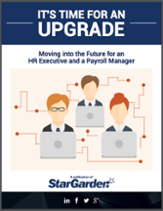How HCM Rules Can Help You Take a REAL Vacation

Think back to your last vacation. How many times did you check your email? Your voicemail? How many times did your coworkers reach out to you in desperation for information or access that only you had?
You’re not alone. Studies show that 30% of Canadians and a 42% of Americans check their email while they’re out of the office on holiday. Even worse is the increasing trend of employees taking less and less vacation at all, despite evidence showing that failing to take vacation has significant negative consequences on our health and personal relationships.
The Biggest Problem: Responsibility and Access
One of the biggest obstacles to taking a vacation and completely disconnecting from the office is that in many modern workplaces, it’s difficult or impossible to efficiently transfer your responsibilities to others. Trying to plan how to cover your responsibilities and anticipate how to handle emergencies that arise while you’re on vacation can be stressful or impossible – resulting in overworked employees that never really take time off.
During the time that many employees, especially managers, are out of the office, work basically stops. Coworkers and team members tread water and try to stay afloat, but can’t move forward on projects because of missing links. Many times, employees back in the office don’t know what tasks have to be done or have enough information to complete them. Other times, it’s just not possible for others to accomplish the absent worker’s tasks, because only the vacationing employee has permissions and access in the online systems. Almost ever office can relate a horror story of that time they had to call a manager at 2 a.m. local time to figure out access information for a pressing emergency matter. Even if the team back at the office tries to accomplish “business as usual,” and the vacationer contributes as necessary via email, the tasks frequently have to be re-done upon his return – wasting effort all around.
The HCM Solution: Automated Rules
The solution to such a problem is quite simple: having automated rules defined to take care of the transferring access and responsibility between employees. When employees maintain task and to-do lists using workflows, and gain access to an integrated system to carry out their tasks and duties, it’s easy to transfer permissions.
For example, specific rules can be established to automatically delegate an employee’s permissions among four other designated employees when they enter “vacation” mode. In this case, things on your task list – and appropriate permissions to complete them – can be automatically transferred to someone who can actually accomplish them in your absence.
Or, like the Huffington Post has begun doing, a company-wide rule can be set up to automatically respond to and archive or delete email while you’re on vacation. (HuffPo’s message offers senders the opportunity to resend their email after the employee’s return date or be redirected to someone who can assist them immediately.)
Using rules and permissions, business can carry on while an employee is out, and the employee can actually enjoy her vacation! Check out our video to learn more about setting up rules and permissions in your HCM systems.
StarGarden’s workflow automation solutions are the answer to helping your business run more efficiently while promoting a balanced company culture. StarGarden’s HCM suite is customizable, mobile-friendly, and complimentary to your existing HR & payroll solutions. See more at www.stargarden.com or contact us for a free demo of our newest integrated software solution, StarGarden 5.0.

